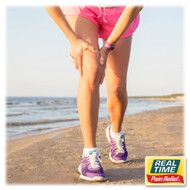5 Tricks to Get Pain Relief for Sports Injuries
14th Feb 2023
Dealing with pain from a sports injury? Recovery time is important! Here are 5 tricks to help you get back to your activity faster.
Whether you are a seasoned athlete or a weekend warrior, sports injuries are extremely common. According to a report from the Centers for Disease Control and Prevention, every year over eight million people develop sports injuries in the United States.
Sports injuries happen for a variety of reasons including poor form, improper equipment, and inefficient warm-up. But whatever the cause, if you develop a sports injury, you want relief. Fortunately, there are several options including natural treatments that can ease discomfort.
Common Types of Sports Injuries
Sports injuries are common in contact sports, such as football, but they can occur in just about any type of activity. Baseball, tennis, and running can often lead to a variety of injuries. Also, anyone that participants in sports can suffer a sports injury regardless of their level of proficiency.
There are several types of sports injuries that can usually be divided into two categories including acute or chronic injuries.
Acute Injuries:
Acute injuries come on suddenly and may include fractures, dislocations, and sprains. Fractures and dislocations require professional medical treatment. Acute sports injuries can also include pulled or strained muscles, which can often be treated at home. Signs and symptoms of an acute sports injury include:
- Sudden pain
- A bone that is visibly out of place
- Inability to put weight on a leg or foot
- Arm or leg weakness
- Inability to move a joint normally
Chronic Injuries:
Some sports injuries are chronic, which means they don’t happen all of a sudden. Instead, a chronic sports injury may occur after playing sports for several months or longer. Chronic sports injuries are often due to repetitive motion, such as serving a tennis ball or pitching. Common types of chronic sports injuries include bursitis, tendinitis, and shin splints. Signs and symptoms of a chronic sports injury include:
- A dull ache
- Stiffness in the affected area
- Swelling
- Pain when playing a sport
Best Pain Relief Methods for a Sports Injury
The best pain relief for a sports injury may depend on the severity of the injury, and the part of the body hurt. For instance, serious injuries, such as a fracture, may require prescription pain medication to ease discomfort.
To relieve pain for common sports injuries, consider using a combination of the following methods:
Rest:
Rest after an acute injury is often an important part of the healing process. Chronic injuries also might require rest or at least a modification of activities. Your doctor can tell you how long you should rest the affected area. You might want to resume normal activities and sports gradually to avoid re-injuring the area.
Topical Pain Relief Lotion:
Topical pain relief lotion is a great option to decrease pain from many types of sports injuries, especially muscle strains. Topical pain relief eases discomfort without the side effects of oral medication. Usually, pain relief lotions can be applied to the affected area several times a day and are very effective at reducing discomfort.
Massage:
Massage can also be a good sports pain relief option. Massage promotes blood flow to the area, which may speed healing. It can also decrease muscle tension and soreness. There are a few different types of massage that may be most effective for sports injuries including sports massage and deep tissue massage.
Ice:
Applying ice to the affected area may help decrease swelling, inflammation, and pain. Ice is best applied within the first 72 hours after an acute sports injury. Apply an ice pack for about 15 to 20 minutes four to eight times a day.
Take a Dip With a Pain Relief Bath Bomb:
Soaking in a warm tub with pain relief bath bomb is also a great way to treat sports injuries. A warm bath relaxes the muscles and decreases tension. Fill a tub with water that is a comfortable temperature for you. Add the bath bomb and soak for 20 to 30 minutes. Look for a bath bomb with ingredients that promote healing. For example, arnica is thought to reduce soreness, swelling, and stiffness that often occur with a sports injury. A bath bomb with Epsom salt is also a good choice. Epsom salt, also called magnesium sulfate, is helpful to decrease pain from sore muscles.
Preventing Sports Injuries
Although the treatment listed above can relieve pain associated with sports injuries, prevention is your best bet. Consider the following suggestions to decrease your chances of developing a sports injury:
- Warm-up with light cardiovascular exercise before starting vigorous sports activities.
- Always wear appropriate and supportive footwear for the type of sport you are participating in.
- If you have a past injury, consider taping the area for added support.
- Use appropriate sport and safety equipment, such as pads and helmets, when participating in certain sports.
- Cross-train to avoid overuse injuries.
- Drink plenty of water when playing sports to avoid muscle cramps.
- Use good form.
- Know your limits. For example, gradually increase your speed or intensity when playing sports.
- Cool down after playing sports by lightly stretching to prevent muscle soreness.
Dealing with Arthritis Pain? (Click Here) to learn how to reduce arthritis pain quickly!
Real Time Pain Relief not only cares about the quality ingredients that go into each and every one of our products – but also about the people who buy them. We hope this blog becomes a valued resource for your own personal journey to better health. For 20 years, Real Time Pain Relief has provided pain relief infused with Nature’s Ingredients. From the useful information in our articles to our high-quality products, we hope you feel better and pass it on!
Sources





